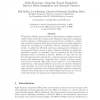Free Online Productivity Tools
i2Speak
i2Symbol
i2OCR
iTex2Img
iWeb2Print
iWeb2Shot
i2Type
iPdf2Split
iPdf2Merge
i2Bopomofo
i2Arabic
i2Style
i2Image
i2PDF
iLatex2Rtf
Sci2ools
NECO
2007
2007
Spike-Frequency Adapting Neural Ensembles: Beyond Mean Adaptation and Renewal Theories
We propose a Markov process model for spike-frequency adapting neural ensembles which synthesizes existing mean-adaptation approaches, population density methods, and inhomogeneous renewal theory, resulting in a unified and tractable framework which goes beyond renewal and mean-adaptation theories by accounting for correlations between subsequent interspike intervals. A method for efficiently generating inhomogeneous realizations of the proposed Markov process is given, numerical methods for solving the population equation are presented, and an expression for the first-order interspike interval correlation is derived. Further, we show that the full five-dimensional master equation for a conductance-based integrate-and-fire neuron with spike-frequency adaptation and a relative refractory mechanism driven by Poisson spike trains can be reduced to a two-dimensional generalization of the proposed Markov process by an adiabatic elimination of fast variables. For static and dynamic stim...
| Added | 27 Dec 2010 |
| Updated | 27 Dec 2010 |
| Type | Journal |
| Year | 2007 |
| Where | NECO |
| Authors | Eilif Mueller, Lars Buesing, Johannes Schemmel, Karlheinz Meier |
Comments (0)

